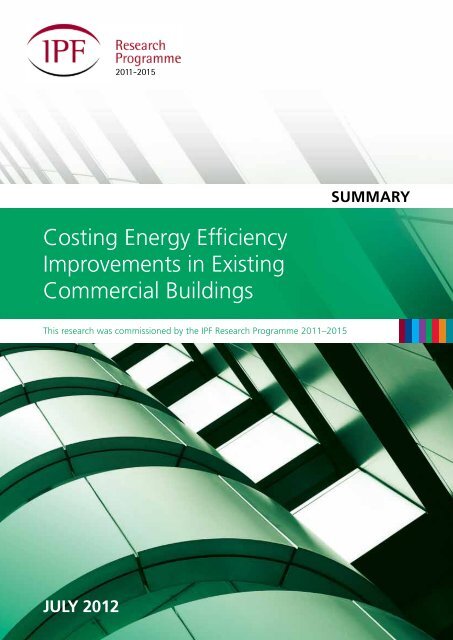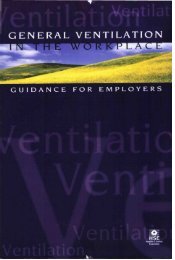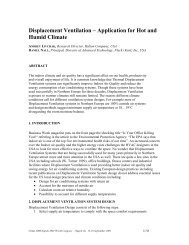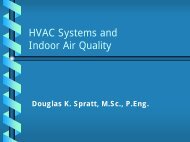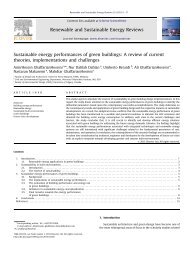Costing Energy Efficiency Improvements in Existing Commercial Buildings
Costing Energy Efficiency Improvements in Existing Commercial Buildings
Costing Energy Efficiency Improvements in Existing Commercial Buildings
Create successful ePaper yourself
Turn your PDF publications into a flip-book with our unique Google optimized e-Paper software.
and retail Property2011-2015SUMMARY<strong>Cost<strong>in</strong>g</strong> <strong>Energy</strong> <strong>Efficiency</strong><strong>Improvements</strong> <strong>in</strong> Exist<strong>in</strong>g<strong>Commercial</strong> Build<strong>in</strong>gsThis research was commissioned by the IPF Research Programme 2011–2015JULY 2012
<strong>Cost<strong>in</strong>g</strong> <strong>Energy</strong> <strong>Efficiency</strong> <strong>Improvements</strong> <strong>in</strong> Exist<strong>in</strong>g <strong>Commercial</strong> Build<strong>in</strong>gsSummaryIPF Research Programme 2011–2015July 2012© 2012 - Investment Property Forum
<strong>Cost<strong>in</strong>g</strong> <strong>Energy</strong> <strong>Efficiency</strong> <strong>Improvements</strong> <strong>in</strong> Exist<strong>in</strong>g <strong>Commercial</strong> Build<strong>in</strong>gsResearchRichard Quarterma<strong>in</strong>e, Sweett (UK) LimitedAzita Dezfouli, Sweett (UK) LimitedDavid Sutton, Sweett (UK) LimitedProject steer<strong>in</strong>g groupLouise Ellison, Qu<strong>in</strong>ta<strong>in</strong> Estates & Development PLCGerry Blundell, ConsultantTim Coff<strong>in</strong>, Universities Superannuation SchemePam Craddock, IPFDisclaimerThis document is for <strong>in</strong>formation purposes only. The <strong>in</strong>formation here<strong>in</strong> is believed to be correct, but cannot be guaranteed,and the op<strong>in</strong>ions expressed <strong>in</strong> it constitute our judgement as of this date but are subject to change. Reliance should notbe placed on the <strong>in</strong>formation and op<strong>in</strong>ions set out here<strong>in</strong> for the purposes of any particular transaction or advice. The IPFcannot accept any liability aris<strong>in</strong>g from any use of this document.
<strong>Cost<strong>in</strong>g</strong> <strong>Energy</strong> <strong>Efficiency</strong> <strong>Improvements</strong> <strong>in</strong> Exist<strong>in</strong>g <strong>Commercial</strong> Build<strong>in</strong>gscontents1. Introduction 12. <strong>Energy</strong>, CO 2and commercial build<strong>in</strong>gs 22.1 CO 2emissions from commercial build<strong>in</strong>gs 22.2 Improvement opportunities for landlords 22.3 Modell<strong>in</strong>g CO 2emissions and energy consumption 33. Build<strong>in</strong>g selection and research method 43.1 Build<strong>in</strong>gs analysed 43.2 <strong>Commercial</strong> build<strong>in</strong>g refurbishments 53.3 <strong>Cost<strong>in</strong>g</strong> process and assumptions 63.3.1 Capital cost 63.3.2 Lifecycle costs and energy sav<strong>in</strong>gs 64. Key f<strong>in</strong>d<strong>in</strong>gss 74.1 Summary 74.2 <strong>Energy</strong> efficiency ‘quick w<strong>in</strong>s’ 84.2.1 Individual improvements to office build<strong>in</strong>gs 94.2.2 Individual improvements to retail build<strong>in</strong>gs 114.2.3 Individual improvements to <strong>in</strong>dustrial/warehouse build<strong>in</strong>gs 115. Conclusion 12
<strong>Cost<strong>in</strong>g</strong> <strong>Energy</strong> <strong>Efficiency</strong> <strong>Improvements</strong> <strong>in</strong> Exist<strong>in</strong>g <strong>Commercial</strong> Build<strong>in</strong>gs
<strong>Cost<strong>in</strong>g</strong> <strong>Energy</strong> <strong>Efficiency</strong> <strong>Improvements</strong> <strong>in</strong> Exist<strong>in</strong>g <strong>Commercial</strong> Build<strong>in</strong>gs11. INTRODUCTIONIn recent years, brand new, highly efficient office build<strong>in</strong>gs have tended to grab the headl<strong>in</strong>es whendiscuss<strong>in</strong>g improved energy performance <strong>in</strong> commercial properties. Opportunities to reduce energyconsumption <strong>in</strong> exist<strong>in</strong>g build<strong>in</strong>gs have been underpublicised for a variety of reasons, the most notable be<strong>in</strong>ga lack of available cost data, appropriateness of certa<strong>in</strong> technologies and their respective energy sav<strong>in</strong>gs,perceived level of disruption to occupiers and the ‘who pays, who ga<strong>in</strong>s’ issue between landlords and tenants.In January 2009, the Investment Property Forum (IPF) published a report <strong>in</strong>vestigat<strong>in</strong>g the costs of mak<strong>in</strong>genergy efficiency improvements to exist<strong>in</strong>g commercial build<strong>in</strong>gs. The primary aims of the org<strong>in</strong>al research 1were to identify the key improvements that could be made to exist<strong>in</strong>g commercial build<strong>in</strong>gs and the build<strong>in</strong>gtypes that presented the greatest opportunities to reduce carbon dioxide (CO 2) emissions.S<strong>in</strong>ce its publication, the research has been used to support strategic decision mak<strong>in</strong>g by the property and<strong>in</strong>vestment community through iddentify<strong>in</strong>g those build<strong>in</strong>gs <strong>in</strong> a portfolio that can yield the largest CO 2sav<strong>in</strong>gs for the least cost. The research has been of particular value to <strong>in</strong>vestment fund managers, assetmanagers, property managers and lett<strong>in</strong>g agents.In the past three years, regulations, <strong>in</strong>centives and Government <strong>in</strong>itiatives have evolved and are driv<strong>in</strong>g amuch greater <strong>in</strong>terest <strong>in</strong> improv<strong>in</strong>g the energy performance of exist<strong>in</strong>g build<strong>in</strong>gs. Key drivers <strong>in</strong>clude:Revised Build<strong>in</strong>g Regulations 2010 (and a proposed future change <strong>in</strong> 2013/14) that will mean that exist<strong>in</strong>gbuild<strong>in</strong>gs will all demonstrate a lower EPC rat<strong>in</strong>g when re-assessed;Introduction and subsequent changes made to the Feed In Tariff <strong>in</strong>centive scheme for solar photovoltaicpanels and w<strong>in</strong>d turb<strong>in</strong>es plus a new <strong>in</strong>centive for the production of renewable heat known as theRenewable Heat Incentive;Proposed simplification of the CRC <strong>Energy</strong> <strong>Efficiency</strong> Scheme;Imm<strong>in</strong>ent implementation of the ‘Green Deal’ <strong>in</strong>novative fund<strong>in</strong>g mechanism, whereby owners andoccupiers of build<strong>in</strong>gs can take out f<strong>in</strong>ance to fund energy efficiency improvements with the repaymentobligation be<strong>in</strong>g attached to the electricity meter rather than the party apply<strong>in</strong>g for the f<strong>in</strong>ance; andGovernment plans to <strong>in</strong>troduce a m<strong>in</strong>imum energy performance standard prevent<strong>in</strong>g landlords from lett<strong>in</strong>gcommercial properties with F and G EPC rat<strong>in</strong>gs from 2018 at the latest.The aim and objectives of the updated research are consistent with the orig<strong>in</strong>al research to provide the samevalue to users as before. However, attention to certa<strong>in</strong> additional objectives is necessary to respond to thechanged environmental agenda affect<strong>in</strong>g exist<strong>in</strong>g commercial build<strong>in</strong>gs. Two additional areas of focus of thework are:1. Identify<strong>in</strong>g the cost and improvement measures required to improve EPC rat<strong>in</strong>gs from the basel<strong>in</strong>e positionfor the build<strong>in</strong>g types analysed.2. Determ<strong>in</strong><strong>in</strong>g what EPC/CO 2reduction targets should be set now to prevent a build<strong>in</strong>g be<strong>in</strong>g either F or Grated <strong>in</strong> 2018.The study analyses a number of commercial build<strong>in</strong>g types and the f<strong>in</strong>d<strong>in</strong>gs are presented from theperspective of a landlord, <strong>in</strong>vestor, developer or owner occupier. Therefore, only the base specification of eachbuild<strong>in</strong>g has been assessed and not the CO 2emissions produced by the tenants’ own equipment, nor how toreduce them.1<strong>Cost<strong>in</strong>g</strong> <strong>Energy</strong> <strong>Efficiency</strong> <strong>Improvements</strong> <strong>in</strong> Exist<strong>in</strong>g Build<strong>in</strong>gs, IPF London, 2009
2 <strong>Cost<strong>in</strong>g</strong> <strong>Energy</strong> <strong>Efficiency</strong> <strong>Improvements</strong> <strong>in</strong> Exist<strong>in</strong>g <strong>Commercial</strong> Build<strong>in</strong>gs2. <strong>Energy</strong>, CO 2and commercial build<strong>in</strong>gs2.1 CO 2emissions from commercial build<strong>in</strong>gsIn 2003, commercial build<strong>in</strong>gs were responsible for around 14% of total CO 2emissions <strong>in</strong> the UK (source:BRE, 2006). Rema<strong>in</strong><strong>in</strong>g emissions were produced by transport (33%), domestic build<strong>in</strong>gs (26%), <strong>in</strong>dustrialprocesses (22%) and public and other build<strong>in</strong>gs (5%). Total emissions from commercial build<strong>in</strong>gs can befurther sub-divided as presented <strong>in</strong> Figure 2.1.Figure 2.1: CO 2emissions from commercial build<strong>in</strong>gs11%13%15%33%FactoriesRetailHospitalityWarehouses<strong>Commercial</strong> offices28%Source: BRE, 2006CO 2emissions are most significant from the stock of and retail build<strong>in</strong>gs, account<strong>in</strong>g for over 60% of allemissions from the commercial sector.2.2 Improvement opportunities for landlordsThe actions of both landlords and tenants have a direct <strong>in</strong>fluence on the energy consumption with<strong>in</strong> abuild<strong>in</strong>g and, <strong>in</strong> turn, the CO 2emitted. The landlord has sole control over the performance of the build<strong>in</strong>gfabric, whereas the tenant is solely responsible for us<strong>in</strong>g the build<strong>in</strong>g <strong>in</strong> terms of hours of use, density ofoccupants, IT equipment efficiency and sett<strong>in</strong>g <strong>in</strong>ternal temperatures. However, both landlords and tenantshave some <strong>in</strong>fluence on the energy efficiency of the <strong>in</strong>stalled build<strong>in</strong>g services <strong>in</strong>sofar as the landlordmay <strong>in</strong>stall the electrical and mechanical systems and the tenant will run them to suit their occupationalrequirements. A tenant may also <strong>in</strong>fluence the specification of the <strong>in</strong>stalled build<strong>in</strong>g services where, forexample, an office development has been built to a shell and core specification by a developer or where aretail unit has been let on a ‘shell only’ basis.There are significant opportunities for landlords to improve the energy efficiency of the commercial build<strong>in</strong>gsthey let to tenants. Key build<strong>in</strong>gs are offices, supermarkets, retail warehouses, light <strong>in</strong>dustrial build<strong>in</strong>gs andwarehouses. Factories and many retail build<strong>in</strong>gs were excluded from the study because the vast majority oftheir emissions result from build<strong>in</strong>g operations by the tenant (for example, factory processes and refrigerationequipment) rather than from the build<strong>in</strong>g. A more detailed discussion of the decision to omit these is <strong>in</strong>cluded<strong>in</strong> the full research report.
<strong>Cost<strong>in</strong>g</strong> <strong>Energy</strong> <strong>Efficiency</strong> <strong>Improvements</strong> <strong>in</strong> Exist<strong>in</strong>g <strong>Commercial</strong> Build<strong>in</strong>gs32. <strong>Energy</strong>, CO 2and commercial build<strong>in</strong>gs2.3 Modell<strong>in</strong>g CO 2emissions and energy consumptionPart L of the Build<strong>in</strong>g Regulations and <strong>Energy</strong> Performance Certificates (EPCs) only regulate and predict aproportion of CO 2emissions <strong>in</strong> a build<strong>in</strong>g as shown <strong>in</strong> Figure 2.2. Specifically, only heat<strong>in</strong>g, cool<strong>in</strong>g, hotwater, ventilation and light<strong>in</strong>g energy consumption is accounted for and standard work<strong>in</strong>g hours andoccupancy are assumed. The modell<strong>in</strong>g process therefore does not <strong>in</strong>clude any allowance for the occupants’equipment or appliances or account for extended work<strong>in</strong>g hours for example.Figure 2.2: Build<strong>in</strong>g energy consumption measures by Part L, EPCs and DECs 2Actual total energy useDesign prediction(Part L & EPC)Actual rated energyuse (DEC)Predicted regulate CO 2Unregulated CO 2Extra occupancy Inefficiencies Special& work<strong>in</strong>g hoursfunctionsRegulated energy use <strong>in</strong>cludes modelled heat<strong>in</strong>g, hot water, cool<strong>in</strong>g, ventilation and energyUnregulated energy use <strong>in</strong>cludes plug load, server rooms, security, external light<strong>in</strong>g, lifts, etc.Extra occupancy and equipment and extra operat<strong>in</strong>g hours (e.g. even<strong>in</strong>g/weekend work<strong>in</strong>g)Inefficiencies from poor control, bad commission<strong>in</strong>g, bad ma<strong>in</strong>tenance, etc.Special functions (separable energy uses) <strong>in</strong>clude trad<strong>in</strong>g floors, server rooms, cafeteria, etc.A Display <strong>Energy</strong> Certificate (DEC), currently only mandatory for public build<strong>in</strong>gs or build<strong>in</strong>gs with publictenants, measures almost all elements of actual energy use <strong>in</strong> a build<strong>in</strong>g whereas an EPC <strong>in</strong>cludes atheoretical prediction of how a build<strong>in</strong>g could perform if realistically upgraded. An EPC therefore reflects thescale of <strong>in</strong>fluence a landlord has to affect energy consumption and CO 2emissions <strong>in</strong> a build<strong>in</strong>g.2Carbon Trust (2011), Clos<strong>in</strong>g The Gap, available from the Carbon Trust website (ref CTG047) www.carbontrust.co.uk
4 <strong>Cost<strong>in</strong>g</strong> <strong>Energy</strong> <strong>Efficiency</strong> <strong>Improvements</strong> <strong>in</strong> Exist<strong>in</strong>g <strong>Commercial</strong> Build<strong>in</strong>gs3. Build<strong>in</strong>g selection and research method3.1 Build<strong>in</strong>gs analysedThe types of commercial build<strong>in</strong>g analysed have been largely ma<strong>in</strong>ta<strong>in</strong>ed as per the orig<strong>in</strong>al study but withcerta<strong>in</strong> revisions. Two key changes are:1. The number of office types analysed has been reduced to produce more consolidated results based on thef<strong>in</strong>d<strong>in</strong>gs of the orig<strong>in</strong>al study.2. The <strong>in</strong>troduction of an office build<strong>in</strong>g compliant with the 2006 Part L regulations to <strong>in</strong>vestigate how the2010 revised regulations will impact upon its EPC rat<strong>in</strong>g.S<strong>in</strong>ce the orig<strong>in</strong>al work was published, Part L of the Build<strong>in</strong>g Regulations has been revised (<strong>in</strong> 2010). Thisrevision means that new non-domestic build<strong>in</strong>gs must achieve on average a 25% reduction <strong>in</strong> CO 2emissionscompared with the 2006 regulations. The change also signifies that build<strong>in</strong>gs constructed prior to the<strong>in</strong>troduction of the 2010 regulations would achieve a poorer EPC rat<strong>in</strong>g if they were to be reassessed now.This is because a build<strong>in</strong>g that is compliant with the latest regulations will score either a B or C rat<strong>in</strong>g(depend<strong>in</strong>g on the servic<strong>in</strong>g strategy) but the change <strong>in</strong> regulations will mean that the build<strong>in</strong>g iscomparatively less efficient, so it will be lower on the EPC scale (i.e. D- or E-rated for example).It should be noted that the build<strong>in</strong>gs modelled are best-fit representations of the exist<strong>in</strong>g stock and not casestudies of actual build<strong>in</strong>gs. These models represent a build<strong>in</strong>g that is let by a landlord to a tenant and do notconsider how the tenant uses the build<strong>in</strong>g or the implications of IT and other equipment they <strong>in</strong>stall.Figure 3.1 gives a notional representation of the base build<strong>in</strong>gs analysed <strong>in</strong> the update study.Figure 3.1: Example build<strong>in</strong>gs represent<strong>in</strong>g the base build<strong>in</strong>g modelsOffice 1Reflects mid-town and West End offices, which are predom<strong>in</strong>antly period,dat<strong>in</strong>g from pre-1940. Heat<strong>in</strong>g system only.Office 2Partly glazed air-conditioned early 1990s, narrow-plan office. Compliantwith 1990 Part L Build<strong>in</strong>g Regulations.
<strong>Cost<strong>in</strong>g</strong> <strong>Energy</strong> <strong>Efficiency</strong> <strong>Improvements</strong> <strong>in</strong> Exist<strong>in</strong>g <strong>Commercial</strong> Build<strong>in</strong>gs53. Build<strong>in</strong>g selection and research methodOffice 3Fully glazed deep-plan air-conditioned office. Compliant with 2002 Part LBuild<strong>in</strong>g Regulations.Office 4As Office 3 but compliant with 2006 Part L Build<strong>in</strong>g Regulations.RetailS<strong>in</strong>gle storey with light<strong>in</strong>g, heat<strong>in</strong>g and air condition<strong>in</strong>g. Limitedw<strong>in</strong>dows. Office and warehouse space <strong>in</strong>cluded. Compliant with 1990Part L Build<strong>in</strong>g Regulations.Industrial/warehouseS<strong>in</strong>gle storey with light<strong>in</strong>g and heat<strong>in</strong>g. Limited w<strong>in</strong>dows or rooflights.Offices <strong>in</strong>cluded. Compliant with 1990 Part L Build<strong>in</strong>g Regulations.3.2 <strong>Commercial</strong> build<strong>in</strong>g refurbishmentsThe refurbishment of an exist<strong>in</strong>g build<strong>in</strong>g to meet a ‘market standard’ specification would naturally reduceoperational CO 2emissions. The def<strong>in</strong>ition of ‘market standard’ is the m<strong>in</strong>imum energy efficiency standarda build<strong>in</strong>g could be refurbished to, given available technology, and to meet regulations. It does not <strong>in</strong>cludeany plant, systems or equipment that are more energy efficient compared to other versions on the market,which, <strong>in</strong> most cases, would come at an <strong>in</strong>creased cost. For example, replac<strong>in</strong>g a 20 year old boiler with a‘market standard’ boiler will see a reduction <strong>in</strong> gas consumption because the new version will be typically90% efficient compared to 65% for the old model. However, a 95% efficient boiler could be specified as partof the refurbishment, which would be more expensive but would save more energy. This study exam<strong>in</strong>es thereduction <strong>in</strong> CO 2emissions result<strong>in</strong>g from a market standard refurbishment and the additional reduction thatcan be achieved if enhanced energy efficiency improvements are specified.
6 <strong>Cost<strong>in</strong>g</strong> <strong>Energy</strong> <strong>Efficiency</strong> <strong>Improvements</strong> <strong>in</strong> Exist<strong>in</strong>g <strong>Commercial</strong> Build<strong>in</strong>gs3. Build<strong>in</strong>g selection and research method3.3 <strong>Cost<strong>in</strong>g</strong> process and assumptions3.3.1 Capital costsThe basis of the research was to assess the costs associated with mak<strong>in</strong>g certa<strong>in</strong> energy efficiencyimprovements that are typically beyond the scope of a market standard refurbishment. To demonstrate whichof these improvements were most cost effective, it was necessary to quantify the ‘extra over’ capital cost ofthe upgrade compared with the respective like-for-like replacement under a market standard refurbishment.The extra over cost was derived from the difference between the capital cost of the upgrade and the capitalcost of the standard refurbishment item. These costs were estimated <strong>in</strong>dividually for each build<strong>in</strong>g typemodelled and represent the total cost to a client of construction work (i.e. cost to the landlord). All costs arecurrent at Q2 2012 price levels.The extra over capital cost has also been calculated for those improvements that could be carried out whilst atenant is (or multiple tenants are) <strong>in</strong> occupation of the build<strong>in</strong>g. Most improvements can be carried out dur<strong>in</strong>geven<strong>in</strong>gs and weekends although there would be an extra cost for undertak<strong>in</strong>g work at these times.3.3.2 Lifecycle costs and energy sav<strong>in</strong>gsFor each energy efficiency improvement, the operational costs and energy sav<strong>in</strong>gs were also calculated.Previously, the <strong>in</strong>ternal rate of return (IRR) and discounted payback period were calculated <strong>in</strong> order to <strong>in</strong>dicate<strong>in</strong>vestment potential. The update study shows all costs and sav<strong>in</strong>gs on an undiscounted basis and providesenough data to allow the user to calculate the f<strong>in</strong>ancial metrics to suit their own particular requirements. Inparticular, the detailed results <strong>in</strong>clude the additional capital cost of each improvement, estimated life of the<strong>in</strong>stallation, gas, electricity and CO 2sav<strong>in</strong>gs (<strong>in</strong> terms of reduced CRC payments) and available <strong>in</strong>centives(where applicable).Current and projected future gas and electricity prices as published by the Department for <strong>Energy</strong> andClimate Change (DECC) were used to estimate the likely f<strong>in</strong>ancial benefit from the energy saved under twoenergy price scenarios.
<strong>Cost<strong>in</strong>g</strong> <strong>Energy</strong> <strong>Efficiency</strong> <strong>Improvements</strong> <strong>in</strong> Exist<strong>in</strong>g <strong>Commercial</strong> Build<strong>in</strong>gs74. Key f<strong>in</strong>d<strong>in</strong>gs4.1 SummaryA key objective of the update study was to identify the cost of improv<strong>in</strong>g the EPC rat<strong>in</strong>g for each build<strong>in</strong>g.This required:The modell<strong>in</strong>g of the build<strong>in</strong>g’s basel<strong>in</strong>e EPC rat<strong>in</strong>g;An assessment of how a ‘market standard’ refurbishment (i.e. no extra expenditure on energy efficiencybeyond meet<strong>in</strong>g regulatory compliance) would <strong>in</strong>herently improve the EPC rat<strong>in</strong>g; andEstablish<strong>in</strong>g the additional cost and benefit of specify<strong>in</strong>g a series of enhanced energy efficiencyimprovements.Summary results for all build<strong>in</strong>gs are presented <strong>in</strong> Table 4.1.Table 4.1: Additional capital cost to improve EPC rat<strong>in</strong>gs when refurbish<strong>in</strong>g exist<strong>in</strong>g commercialbuild<strong>in</strong>gsOffice 1 Office 2 Office 3 Office 4 RetailIndustrial /warehouseEPC rat<strong>in</strong>gBasel<strong>in</strong>e E G F E D FMarket refurb D F F E 3 C BAdditional capital cost extra over market standard refurbishment 4 (%)E 0.3% 1.0%D 1.7% 1.9% 1.0%C 0.8% 14.6% 12.6% 12.8%B 14.1% 37.3% 44.7% 45.7% 2.6%A 40.0% - - - - 20.7%Headl<strong>in</strong>e f<strong>in</strong>d<strong>in</strong>gs are:a. As expected, offices have become more energy efficient s<strong>in</strong>ce the early 1990s because build<strong>in</strong>g regulationshave driven a reduction <strong>in</strong> CO 2emissions. Non-air-conditioned offices also perform better <strong>in</strong> terms of theirEPC rat<strong>in</strong>g compared to air-conditioned offices.b. A ‘market standard’ refurbishment can improve the EPC rat<strong>in</strong>g by at least one grade for most build<strong>in</strong>gs.The improvement is substantial for the <strong>in</strong>dustrial/warehouse build<strong>in</strong>g (i.e. rat<strong>in</strong>g improves from an F to a B).c. All offices can be improved by an extra grade for an additional cost of up to 1% of the refurbishmentbudget which is potentially viable for most projects.d. Air-conditioned offices built over 10 years ago (Offices 2 and 3) represent the most cost effectiveopportunity because EPC rat<strong>in</strong>gs can be improved by two EPC grades for a total extra spend of circa 2%.e. The EPC rat<strong>in</strong>g of the retail build<strong>in</strong>g can be improved to a B for an additional capital sum of 2.6% abovethe standard refurbishment cost and, therefore, this is attractive <strong>in</strong> terms of future-proof<strong>in</strong>g the asset.f. It is unviable to achieve an A-rated EPC for all build<strong>in</strong>gs (<strong>in</strong>clud<strong>in</strong>g the <strong>in</strong>dustrial/warehouse, which canachieve a B rat<strong>in</strong>g through refurbish<strong>in</strong>g to a market standard).3A ‘market refurbishment’ would not be carried out to a build<strong>in</strong>g which is less than 10 years old hence no improvement <strong>in</strong> the EPC rat<strong>in</strong>g.4All costs are cumulative.
8 <strong>Cost<strong>in</strong>g</strong> <strong>Energy</strong> <strong>Efficiency</strong> <strong>Improvements</strong> <strong>in</strong> Exist<strong>in</strong>g <strong>Commercial</strong> Build<strong>in</strong>gs4. Key f<strong>in</strong>d<strong>in</strong>gsIt is also anticipated that the EPC rat<strong>in</strong>g for the office built after 2006 (Office 4) will drop from an E to anF follow<strong>in</strong>g the next revision to Part L based on a comparison between the 2006 and 2010 versions of theregulations. The proposed m<strong>in</strong>imum energy efficiency standards for build<strong>in</strong>gs let by landlords to be <strong>in</strong>troducedby 2018 will mean that even offices built to recent standards will be affected by this forthcom<strong>in</strong>g legislation.This will also apply to retail and <strong>in</strong>dustrial/warehouse build<strong>in</strong>gs. The <strong>in</strong>creased energy efficiency standardsunder the Build<strong>in</strong>g Regulations will undoubtedly result <strong>in</strong> the <strong>in</strong>dustrial/warehouse build<strong>in</strong>g be<strong>in</strong>g rated as a Gby 2018 and it is likely that the retail build<strong>in</strong>g would be rated as F or G and thus be affected by the m<strong>in</strong>imumstandards. An EPC is valid for 10 years and, therefore, a currently certified build<strong>in</strong>g might be temporarilyshielded from the impact of the 2018 standard but any refurbishment work or request from a prospectivebuyer or tenant for an updated EPC might expose the landlord to the new rules.4.2 <strong>Energy</strong> efficiency ‘quick w<strong>in</strong>s’The update study has demonstrated that there are common energy efficiency ‘quick w<strong>in</strong>s’ across a range ofcommercial build<strong>in</strong>g types that are low cost to implement and can improve EPC rat<strong>in</strong>gs by either one or twogrades. These ‘quick w<strong>in</strong>s’ are:Boilers (95% efficiency);Daylight controls;Improv<strong>in</strong>g air tightness;Variable speed heat<strong>in</strong>g and cool<strong>in</strong>g pumps;Heat<strong>in</strong>g controls;Power factor correction (>0.95);High-efficiency chillers;T5 light<strong>in</strong>g;Heat recovery; andDC drive fan coil units.These ‘quick w<strong>in</strong>s’ can either form part of a general refurbishment dur<strong>in</strong>g a period of vacant possession orbe ‘one-off’ improvements when the build<strong>in</strong>g is wholly or partly occupied. This is an important considerationwhen a planned refurbishment is some years away and one or more leases are due to expire. The <strong>in</strong>troductionof EPCs has made tenants acutely aware of how build<strong>in</strong>gs perform <strong>in</strong> terms of their energy performanceand the issue is likely to be prevalent dur<strong>in</strong>g lease negotiations. If a landlord carries out a few ‘quick w<strong>in</strong>s’ toimprove the rat<strong>in</strong>g of a build<strong>in</strong>g, these could assist a lease renewal, reduce void periods and potentially affectthe rental level achieved.Replac<strong>in</strong>g light<strong>in</strong>g and fan coil units poses particular challenges, especially for retail build<strong>in</strong>gs, but can still beimplemented ‘out of hours’, over an extended period of time.The premium to undertake these works out of hours would typically be no more than 7% because the extracost of labour is offset by not hav<strong>in</strong>g to pay ma<strong>in</strong> contractor’s prelim<strong>in</strong>aries, overheads and profit.
<strong>Cost<strong>in</strong>g</strong> <strong>Energy</strong> <strong>Efficiency</strong> <strong>Improvements</strong> <strong>in</strong> Exist<strong>in</strong>g <strong>Commercial</strong> Build<strong>in</strong>gs94. Key f<strong>in</strong>d<strong>in</strong>gs4.2.1 Individual improvements to office build<strong>in</strong>gsTable 4.2 identifies the energy efficiency improvements that need to be implemented to improve the EPCrat<strong>in</strong>gs above market standard for each office and the additional cost of specify<strong>in</strong>g these measures comparedto the cost of a market standard refurbishment. All costs are cumulative.The research found that there were often alternative strategies that were more cost effective to meetparticular EPC rat<strong>in</strong>gs rather than a strategy based on market standard cost only. It is recommended that afull options appraisal with f<strong>in</strong>ancial cost-benefit analysis is undertaken prior to any refurbishment works todeterm<strong>in</strong>e the most cost-effective way of cutt<strong>in</strong>g CO 2and secur<strong>in</strong>g improved EPC rat<strong>in</strong>gs.Table 4.2: Office EPC improvement strategiesAdditional Capital Cost (%)EPC Rat<strong>in</strong>g Office 1 Office 2 Office 3 Office 4Cost <strong>Improvements</strong> Cost <strong>Improvements</strong> Cost <strong>Improvements</strong> Cost <strong>Improvements</strong>E 0.3% DaylightcontrolsVS pumpsD 1.7% Power factorChillerAir tightnessBoiler 95%Heat recovery1.0% Power factorVS pumpsChiller1.9% Specificfan powerDaylightcontrols1.0% VS pumpsChillerDaylightcontrolsC 0.8% DaylightcontrolsAir tightnessVS pumpsHeat<strong>in</strong>gcontrolsPower factor14.6% Heat<strong>in</strong>gcontrolsSpecific fanpowerPIR controlsLED light<strong>in</strong>gPassivechilled beams12.6% Boiler 95%Externalshad<strong>in</strong>g12.8% Boiler 95%Specificfan powerExternalshad<strong>in</strong>gB 14.1% Air sourceheat pumpsPV 375m237.3% PV 375m 2Externalshad<strong>in</strong>g44.7% LED Light<strong>in</strong>gHeat<strong>in</strong>gcontrolsPassivechilled beams45.7% Heat recoveryLED light<strong>in</strong>gPassivechilled beamsA 40.0% LED light<strong>in</strong>gPIR controlsDoubleglaz<strong>in</strong>g- - - - - -Key: PV = photovoltaic panels; PIR = passive <strong>in</strong>fra-red; VS = variable speed; LED = light-emitt<strong>in</strong>g diodeThe forego<strong>in</strong>g results <strong>in</strong>dicate that EPC rat<strong>in</strong>gs for all offices can be improved by an extra grade for anadditional cost of up to 1% of the refurbishment budget. This is a relatively m<strong>in</strong>or amount to spend whenundertak<strong>in</strong>g a refurbishment project to secure a better EPC rat<strong>in</strong>g.Air-conditioned offices built over 10 years ago (Offices 2 and 3) represent the most cost effective opportunityto further enhance EPC rat<strong>in</strong>gs and cut CO 2. For a total extra spend of circa 2%, the EPC can be improved bytwo rat<strong>in</strong>gs above a market standard refurbishment (i.e. F to D for both Offices 2 and 3). Improv<strong>in</strong>g the EPCto a C rat<strong>in</strong>g becomes significantly more expensive and requires additional expenditure of 12% or more.
10 <strong>Cost<strong>in</strong>g</strong> <strong>Energy</strong> <strong>Efficiency</strong> <strong>Improvements</strong> <strong>in</strong> Exist<strong>in</strong>g <strong>Commercial</strong> Build<strong>in</strong>gs4. Key f<strong>in</strong>d<strong>in</strong>gsFor Offices 1 and 4, improv<strong>in</strong>g EPC rat<strong>in</strong>gs by two grades is less cost effective compared to the other offices,as an additional total <strong>in</strong>vestment of around 12% to 15% is required.It is possible to improve the EPC rat<strong>in</strong>gs to either a C or B for air-conditioned offices but it is expensive to doso. An A-rated EPC was not practically achievable based on the improvements considered although it mightbe possible if a more detailed analysis was undertaken and further options explored. The naturally ventilatedoffice could achieve an A rat<strong>in</strong>g but the cost would be prohibitive as refurbishment costs would need to<strong>in</strong>crease by a stagger<strong>in</strong>g 40%.The ‘quick w<strong>in</strong>s’ shown <strong>in</strong> Table 4.2 can either form part of a general refurbishment dur<strong>in</strong>g a period ofvacant possession or as ‘one-off’ improvements when the build<strong>in</strong>g is wholly or partly occupied. The workwill be done predom<strong>in</strong>antly out of hours. However, significant items of work <strong>in</strong> an occupied office will takeconsiderably more time to undertake. This <strong>in</strong>cludes light<strong>in</strong>g and fan coils units. It might be favourable torefra<strong>in</strong> from undertak<strong>in</strong>g these types of improvements until the next planned refurbishment if it is <strong>in</strong> the shortto medium term. Chilled beams and fabric enhancement measures (with the exception of external shad<strong>in</strong>g)would not be undertaken when a build<strong>in</strong>g is occupied due to the level of disruption such works would cause.4.2.2 Individual improvements to retail build<strong>in</strong>gsTable 4.3 identifies the energy efficiency improvements that need to be implemented to improve the EPCrat<strong>in</strong>g for the retail build<strong>in</strong>g and the additional cost of specify<strong>in</strong>g these measures compared to the cost of amarket standard refurbishment. All costs are cumulative.Table 4.3: Retail EPC improvement strategyEPC Rat<strong>in</strong>g Additional Capital Cost (%)Cost<strong>Improvements</strong>B 2.6% Power factor correctionVariable speed pumpsDC drive fan coilsAir tightnessHeat recoveryBoiler 95%ChillerA - -The results <strong>in</strong>dicate that a B-rated EPC can be achieved by spend<strong>in</strong>g an additional 2.6% over and above thecost of a market standard refurbishment project. Further improvements become significantly more expensiveand, <strong>in</strong> practice, it would be difficult to achieve an A rat<strong>in</strong>g based on the improvements considered (which<strong>in</strong>cluded several low- and zero-carbon energy sources).The ‘quick w<strong>in</strong>s’ shown <strong>in</strong> Table 4.3 can either form part of a general refurbishment dur<strong>in</strong>g a period of vacantpossession or as ‘one-off’ improvements when the build<strong>in</strong>g is wholly or partly occupied. However, due to thehigh hours of use of retail build<strong>in</strong>gs compared to offices, improvements to light<strong>in</strong>g and fan coil units out ofhours are not likely to be feasible without a high risk of disrupt<strong>in</strong>g trad<strong>in</strong>g activities. It is advisable, therefore,to refra<strong>in</strong> from undertak<strong>in</strong>g these types of improvements until the next planned refurbishment.
<strong>Cost<strong>in</strong>g</strong> <strong>Energy</strong> <strong>Efficiency</strong> <strong>Improvements</strong> <strong>in</strong> Exist<strong>in</strong>g <strong>Commercial</strong> Build<strong>in</strong>gs114. Key f<strong>in</strong>d<strong>in</strong>gs4.2.3 Individual improvements to <strong>in</strong>dustrial/warehouse build<strong>in</strong>gsTable 4.4 identifies the energy efficiency improvements that need to be implemented to improve the EPCrat<strong>in</strong>g for the <strong>in</strong>dustrial/warehouse build<strong>in</strong>g and the additional cost of specify<strong>in</strong>g these measures compared tothe cost of a market standard refurbishment. All costs are cumulative.Table 4.4: Industrial/warehouse EPC improvement strategyEPC Rat<strong>in</strong>g Additional Capital Cost (%)Cost<strong>Improvements</strong>A 20.7% Power factor correctionVariable speed pumpsBoiler 95%External wall <strong>in</strong>sulationHeat controlWarm air blowersW<strong>in</strong>d turb<strong>in</strong>e (20kWp)Photovoltaics (750m²)The results <strong>in</strong>dicate that an A-rated EPC can be achieved by spend<strong>in</strong>g an additional 20% over and abovethe cost of a market standard refurbishment. This would be a significant <strong>in</strong>crease to the base refurbishmentcost and not feasible <strong>in</strong> most cases. A large photovoltaic array and a w<strong>in</strong>d turb<strong>in</strong>e would also be needed toachieve an A rat<strong>in</strong>g, which will not be feasible for some build<strong>in</strong>gs.Most improvements considered for the refurbishment scenario are potentially viable as ‘one-offs’ when the<strong>in</strong>dustrial/warehouse build<strong>in</strong>g is occupied. However, replac<strong>in</strong>g the full light<strong>in</strong>g system would require moretime to complete if undertaken at weekends.


